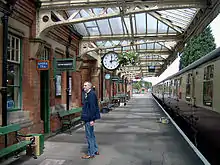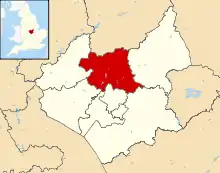Loughborough
Loughborough (/ˈlʌfbərə/ (![]() listen) LUF-bər-ə) is a town in the Charnwood borough of Leicestershire, England, seat of Charnwood Borough Council, and home to Loughborough University. The town had a population of 59,933 in 2011 census, and an estimate of 67,956 in 2019, making it the second largest settlement in Leicestershire,[1] It is close to the Nottinghamshire border and within short distances of Leicester, Nottingham, East Midlands Airport and Derby. The town has the world's largest bell foundry – John Taylor Bellfounders – which made bells for the Carillon War Memorial, a landmark in the Queens Park in the town, of Great Paul for St Paul's Cathedral, and for York Minster.
listen) LUF-bər-ə) is a town in the Charnwood borough of Leicestershire, England, seat of Charnwood Borough Council, and home to Loughborough University. The town had a population of 59,933 in 2011 census, and an estimate of 67,956 in 2019, making it the second largest settlement in Leicestershire,[1] It is close to the Nottinghamshire border and within short distances of Leicester, Nottingham, East Midlands Airport and Derby. The town has the world's largest bell foundry – John Taylor Bellfounders – which made bells for the Carillon War Memorial, a landmark in the Queens Park in the town, of Great Paul for St Paul's Cathedral, and for York Minster.
| Loughborough | |
|---|---|
 Loughborough Market Place | |
 Loughborough Location within Leicestershire | |
| Population | 66,611 (2018) |
| OS grid reference | SK536195 |
| District | |
| Shire county | |
| Region | |
| Country | England |
| Sovereign state | United Kingdom |
| Post town | LOUGHBOROUGH |
| Postcode district | LE11 |
| Dialling code | 01509 |
| Police | Leicestershire |
| Fire | Leicestershire |
| Ambulance | East Midlands |
| UK Parliament | |
History
Medieval
The earliest historical reference to Loughborough was as "Loughburne" in the 1086 Domesday Book.[2] It appeared in a charter from the reign of Henry II as Loughburga, and in the Pipe Rolls of 1186 as Loughburc. The name means "Lough's borough or fortified place".[3]
Industrialisation
The first sign of industrialisation in the Loughborough district came in the early years of the 19th century, when John Heathcoat, an inventor from Derbyshire patented in 1809 an improvement to the warp loom, known as the twisted lace machine, which allowed mitts with a lace-like appearance to be made.
Heathcoat, in partnership with the Nottingham manufacturer Charles Lacy, moved his business from there to the village of Hathern, outside Loughborough. The product of this "Loughborough machine" came to be known as English net or bobbinet. However, the factory was attacked in 1816 by Luddites thought to be in the pay of Nottingham competitors and 55 frames were destroyed. This prompted Heathcoat to move his business to a disused woollen mill in Tiverton, Devon.[4]
In 1888 a charter of incorporation was obtained, allowing a mayor and corporation to be elected. The population increased from 11,000 to 25,000 in the following ten years.
Among the factories established were Robert Taylor's bell foundry John Taylor & Co and the Falcon works, which produced steam locomotives, then motor cars, before it was taken over by Brush Electrical Machines. In 1897, Herbert Morris set up a factory in the Empress Works in Moor Lane which become one of the foremost crane manufacturers by the mid-20th century.[5]
There was also strong municipal investment: a new sewage works in 1895, then a waterworks in Blackbrook and a power station in Bridge Street in 1899. The corporation took over the Loughborough Gas Company in 1900.
Tourism
In 1841, Loughborough was the destination for the first package tour, organised by Thomas Cook for a temperance group from Leicester.
Modern history
As Loughborough grew in the 20th century, it gained new suburbs. Thorpe Acre in the north-west of Loughborough was a hamlet of about twenty dwellings until the mid-20th century. Several earlier survivors include a 19th-century church – All Saints Church, Thorpe Acre with Dishley, built in 1845 and extended in 1968 – and a hostelry, The Plough Inn. The population is counted into the Loughborough–Garendon Ward of Charnwood Council. Many roads there are named after poets. After the Second World War, some of Thorpe Acre developed further, mainly in the 1950s for employees of Brush Engineering Works, with 100 dwellings built of no-fines concrete.[6] In the 1960s and early 1970s, Thorpe Acre gained a new estate that subsumed the old village. Two of Loughborough's secondary schools, Charnwood College and De Lisle College, lie on its bounds, as does Garendon Park, a large deer park from the 18th century. The original Dishley, off Derby Road, was heavily developed along with Thorpe Acre in the 1970s. Dishley Church in Derby Road is now in ruins. The agriculturalist Robert Bakewell (1726–1795) is buried there.
Shelthorpe and surrounding area are new suburbs in the south of Loughborough. Work on the original Shelthorpe started in 1929, but was halted by World War II and resumed in 1946. It now has two rows of shops. A magnificent but often overlooked piece of architecture is a group of twelve houses surrounding the crossroads at Castledine Street Extension, Woodthorpe Road, and Shelthorpe Road.
Fairmeadows Way and the surrounding area to the west of Shelthorpe and the south of the university date from the 1970s. The area stretches from Holywell Drive to Hazel Road. Rainbows, a children's hospice,[7] and the secondary Woodbrook Vale School are on the edge of the suburb. Grange Park is to the south of these. Construction began in 2006 after the completion of Terry Yardley Way to One Ash Roundabout. By 2018 the developers William Davis had built 1000 houses. Other developers were also building to the west of Shelthorpe and the south of the university.
William Davis came under fire in 2018 from residents saying they had been promised public amenities like shops and a place of worship, but were living on "a construction site" after William Davis submitted a planning application for 30 more houses on a site that could have been used for public purposes.[8] Despite criticism, the borough council approved the plans. Most of the housing schemes in the area have been completed.
Persimmon Homes and William Davis Homes unveiled controversial plans in 2013 to build 3,200 houses on Garendon Park as the West of Loughborough Sustainable Urban Extension. The plans were approved in 2018, and a new roundabout was under construction shortly afterwards, which will also connect to the new Science and Enterprise Park to the south.
Transport
Rail
Loughborough station is a mainline station serving the town. In 2012, Network Rail redeveloped the station increasing the length of the platforms and improving access; concurrently, the local council made improvements to the surrounding area. East Midlands Railway is the primary operator providing services on the Midland Main Line south to Leicester, Bedford, Luton and London St Pancras stations and north to Lincoln, Derby, Sheffield, Leeds and York stations. The link to London is twice-hourly and provides a link to Europe via Eurostar. Leicester and Derby stations allow transfers to CrossCountry trains running between the north-east of Scotland and the south-west of England.
There were at one time three railway routes to the town: the still-operating Midland Main Line, the Great Central Railway that closed as a result of the Beeching cuts and a branch line from Nuneaton that was part of the London & North Western Railway. Loughborough Central railway station served the Great Central Railway. It was opened on 15 March 1899 and closed in 1969 but re-opened in March 1974 as part of the Great Central heritage railway.[9] The railway is split into two sections north and south of Loughborough. Loughborough Central station is the northern terminus of the southern section of the railway and services run daily. As of 2017, there were plans to fill the gap and link the two halves of the railway again.[10] Thus, a new bridge was installed over the Midland Main Line. Work is now progressing on restoring another bridge over the Grand Union Canal.
| Station | Part of line | Serving area |
|---|---|---|
| Ruddington Transport Centre | Nottingham mainline | Ruddington |
| Rushcliffe Halt | Nottingham mainline | East Leake (British Gypsum) |
| Loughborough Central | Leicester mainline | Loughborough |
| Quorn & Woodhouse | Leicester mainline | Quorn, Woodhouse |
| Rothley | Leicester mainline | Rothley |
| Mountsorrel Halt | Mountsorrel branchline | Mountsorrel |
| Belgrave & Birstall (Leicester North) | Leicester mainline | Birstall |
Brush Traction, a manufacturer of railway locomotives, is also located in the town, adjacent to the Midland railway station.
Motorways
The M1's Junction 23 lies just to the west of Loughborough. The north of the town can be accessed from Junction 24, travelling through Kegworth and Hathern on the A6 road and the south west of the town from Junction 22, via Copt Oak and the small hamlet of Nanpantan.
Buses
Local buses around Loughborough are operated by Arriva Midlands, Kinchbus,[11] Paul S Winson and Robert's Coaches, with longer distance services to Melton Mowbray and Nottingham provided by Centrebus, Nottingham City Transport and trentbarton. There are also various services to Leicester.[12]
Waterways
The River Soar passes by to the east of the town. Navigation from Loughborough north towards the Trent was achieved in 1778 by the Loughborough Navigation, which terminates at Loughborough Wharf between Derby Road and Bridge Street. Subsequently, the Leicester navigation was constructed, connecting to the Loughborough Navigation at Chain Bridge and to the River Soar south of the town. Both form part of the Grand Union Canal.
The now derelict Charnwood Forest Canal once linked Nanpantan (on the west side of Loughborough) with Thringstone, with goods being carried into Loughborough by a horse-drawn wagonway.
Economy
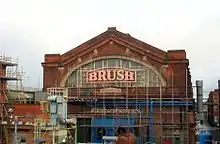
The centre of Loughborough's shopping area is the pedestrianised Market Place and Market Street, which maintain a number of original art deco buildings, such as the building that currently houses the town's Odeon cinema. A large outdoor market is held in the Market Place every Thursday and Saturday. There is a monthly farmers' market. The first mention of a market in Loughborough is in 1221.
The Rushes shopping centre has also been built on the site of the former bus station and is occupied by national chains. The Rushes is linked to the town centre area by Churchgate and Churchgate Mews; the latter has independent shops.
A major new development, the Eastern Gateway, that developed the area around the railway station with a new road and new housing, was completed in 2013.
Pedestrianisation of the town centre was completed in November 2014. The scheme is intended to improve the economy within the town centre and reduce pollution from traffic congestion.
A new Cineworld cinema complex with several restaurants on Baxter Gate, on the site of the former General Hospital, was completed in 2016.
Press
Loughborough's local weekly newspaper is the Loughborough Echo. The town is also served by Leicestershire's daily newspaper, the Leicester Mercury.
Climate
| Sutton Bonington, Nottinghamshire (7.5 kilometres (5 mi) from Loughborough) | ||||||||||||||||||||||||||||||||||||||||||||||||||||||||||||
|---|---|---|---|---|---|---|---|---|---|---|---|---|---|---|---|---|---|---|---|---|---|---|---|---|---|---|---|---|---|---|---|---|---|---|---|---|---|---|---|---|---|---|---|---|---|---|---|---|---|---|---|---|---|---|---|---|---|---|---|---|
| Climate chart (explanation) | ||||||||||||||||||||||||||||||||||||||||||||||||||||||||||||
| ||||||||||||||||||||||||||||||||||||||||||||||||||||||||||||
| ||||||||||||||||||||||||||||||||||||||||||||||||||||||||||||
Like most of the British Isles, Loughborough experiences a maritime climate with cool summers and mild winters. The nearest Met Office weather station is at Sutton Bonington in Nottinghamshire, located 5 miles due north of the town centre. The highest temperature recorded in that area was 36.0 °C (96.8 °F)[14] on 25 July 2019.
Sport
The town was once home to a professional football club, Loughborough FC, which played at the Athletic Ground and was a member of the Football League in the late 19th century. Loughborough Dynamo of the Northern Premier League Division One South East (Level 8 of the men's football pyramid), Loughborough University of the United Counties League Premier Division (Level 9 of the men's football pyramid) and women's team Loughborough Foxes of the FA Women's National League North (Level 3 of the women's football pyramid) are the most prominent football teams in the town currently.
Cricket is prominent, with the Old Contemptibles,[15] Loughborough Town CC, Loughborough Outwoods CC, Loughborough Carillon CC, Loughborough Carillon Old Boys' CC, Loughborough University Staff CC, Loughborough Greenfields CC and Loughborough Lightning of the semi-professional Women's Cricket Super League representing various standards of cricket in the area. Loughborough Town has since 2000 been the most successful club in the Leicestershire and Rutland Cricket League. The university is home to the ECB National Cricket Academy, used by the England team as their primary training centre.
The University's 1st XV rugby team, the Loughborough Students RUFC, were promoted to the National One division in 2012, which is the 3rd tier of English rugby. The town rugby union club, Loughborough RFC, play at Derby Road playing fields. The club was formed in 1891.
Other sports teams include the Loughborough Aces (collegiate American football), Loughborough Lightning of the Netball Superleague and Loughborough Hawks, an amateur netball team. The town also has its own swimming club, Loughborough Town Swimming Club, which is based in the town and trains at local venues.
The tennis tournament Aegon Pro-Series Loughborough is held in Loughborough.
Arts and heritage
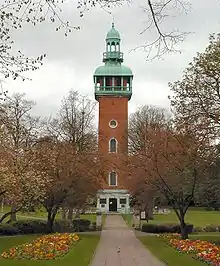
Loughborough has five museums, the largest being the centrally located Charnwood Museum, which houses a range of exhibits reflecting the natural history, geology, industry and history of the area. Nearby in Queens Park is the Carillon and War Memorial, home to a small museum of military memorabilia from the First and Second World Wars. Loughborough Library is on Granby Street.[16]
Also to be found in the town centre, near the fine medieval All Saints parish church, is the Old Rectory.[17] Dating back to 1288 the remaining portion of the Great Hall has been restored and houses a small museum run by the Loughborough Archaeological and Historical Society.
Loughborough has for more than a century been the home of John Taylor & Co bell founders and the firm has a museum – the Bellfoundry Museum – located on two floors telling the story of bell making over the centuries. The recording of the tolling bell at the beginning of "Hells Bells", the first track on AC/DC's 1980 album Back in Black was made on a quarter weight near replica of the Denison bell in the Carillon war memorial.
There is a museum at the Great Central Railway station illustrating the history of the railway from its earliest days up to its present state as a double-track preserved heritage railway.
Although it has no dedicated art gallery, fine pieces of sculpture can be found in the town's environs, including recently installed sculptures from a local artist in commemoration of the First World War Centenary outside of Charnwood Museum, and The Sockman,[18] a bronze statue celebrating Loughborough's association with the hosiery industry. This can be found in the Market Place near the Loughborough Town Hall, which itself contains a number of art works.
The Loughborough Town Hall is the venue for a range of events, including concerts, exhibitions, musicals, comedy shows and a Christmas pantomime. Groups make use of the town hall for their shows.
Events are also organised by Charnwood Arts, a voluntary managed and professionally staffed body, which promotes a year-round programme of professional performances across the borough. The organisation is responsible for The Picnic In the Park event, which was inaugurated in 1980 and is held in Queens Park in May. Streets Alive, jointly organised by Charnwood Arts and Charnwood Borough Council takes place at a similar time of year.
The Loughborough Canal Festival, which ran from 1997 to 2014, was an annual event in May centred on Chain Bridge.
Great Central Railway is a heritage railway based at Loughborough Central Station, which is south of the town centre. It is operated largely by volunteers and trains run every weekend of the year and bank holidays, as well as daily during the summer.
Every November, the street fair takes over the centre of the town, closing some roads. The fair runs from Wednesday afternoon until Saturday night. The fair has many rides, amusement arcades, food stands and games.
The town has an Odeon cinema. This cinema was designed by Archibald Hurley Robinson. There are six screens in the theatre, which is built to an art deco style. The cinema was built in 1914 as the Empire Cinema, and was remodelled in 1936 by Archibald Hurley Robinson as the New Empire Cinema. Over the years it has been named the Palm Court and Ballroom, Empire, Essoldo, Classic, Curzon and Reel.
The site of the former Loughborough General Hospital was demolished in 2012, and was replaced by a Cineworld cinema with eight screens, which opened in 2016.
Education
Uniformed youth organisations
Loughborough has a variety of uniformed youth organisations, with several Scout and Girl Guide units, Girls' and Boys' Brigades, units from the cadet forces (Air Training Corps, Army Cadet Force, Sea Cadet Corps, and Combined Cadet Force at Loughborough Grammar School), a St John Ambulance Cadet unit, and a cadet programme run by the local Fire and Rescue Service. Since November 2015, Loughborough has also had a Volunteer Police Cadet unit based at Loughborough College.[19]
Schools
Loughborough University
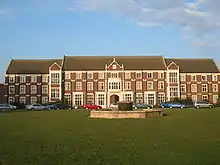
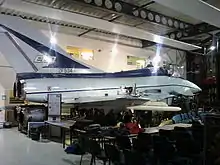
In 2004, Loughborough University was ranked 9th among British universities by the Times' Good University Guide. In 2006 Loughborough was ranked 6th. In 2007 The Guardian rated the university 8th, and 10th of 117 institutions by The Guardian League Tables 2009 (published online 1/6/08 for the 2009–2010 academic year. The university is 5th in some rankings, behind Oxbridge and the London universities. The university has the largest sports scholarship in the UK. More than 250 international athletes study and train there. In 2008 Loughborough was named Sunday Times University of the Year.[20]
Loughborough College
Loughborough College is the second biggest education establishment in Loughborough, after the University. It offers further education and vocational courses. It was established in 1909, and has over 12,000 full and part-time students.
RNIB College, Loughborough
RNIB College, Loughborough is for people aged 16+ and adults with a wide range of disabilities seeking to access education, employment and independent living.
Notable people
Loughborough natives include Albert Francis Cross, the journalist, author, poet and playwright who was born on Moor Lane on 9 May 1863, the two time Laurence Olivier Award nominated stage actress Nicola Hughes and Coronation Street's Roy Cropper actor David Neilson, and the notorious rock star of the mid-1960s, Viv Prince of the Pretty Things. Bobsleigher and Paratrooper Dean Ward, who won a bronze medal at the 1998 Winter Olympics was born in the town. Felix Buxton of Basement Jaxx was a pupil at Loughborough Grammar School and son of the one-time vicar of nearby Woodhouse Eaves and Ibstock.[21] The Dundee-born comedian, TV presenter and entertainer Danny Wallace attended Holywell County Primary School. Second World War fighter ace Johnnie Johnson attended Loughborough Grammar school. The high jumper Ben Challenger, son of Showaddywaddy drummer Romeo Challenger, is from Loughborough. The popular Muslim and Bangladeshi presenter Rizwan Hussain was brought up there.
Notable sporting graduates of Loughborough University include Sir Clive Woodward, Sebastian Coe, Paula Radcliffe, David Moorcroft, Tanni Grey-Thompson, Monty Panesar, Steve Backley, Jack Kirwan and Lawrie Sanchez.
Loughborough was the birthplace of the poet and Royalist John Cleveland (1613–1658).[22]
The chemist Arthur Donald Walsh FRS (8 August 1916 – 23 April 1977) was born in Loughborough and attended Loughborough Grammar School.[23] The engineer, physicist and author Charles Denis Mee was born here in 1927.[24] The bellfounder John William Taylor (1827-1906) of John Taylor & Co lived and died here.
John Paget (1808–1892), an English agriculturist and writer on Hungary, was born here.
Professional footballers, Liam Moore and Hamza Choudhury were both born in the town and have gone on to play in the Premier League with nearby Leicester City. Fred Ainsworth was also born here. England Rugby union captain Phil de Glanville was born in the town.
Sue Campbell, Baroness Campbell of Loughborough Sue_Campbell,_Baroness_Campbell_of_Loughborough current Head of FA Women's football
Nicky Morgan, Baroness Morgan of Cotes Nicky Morgan
Twin towns

Loughborough is twinned with:
 Épinal, Vosges, France[25]
Épinal, Vosges, France[25].svg.png.webp) Gembloux, Namur, Belgium
Gembloux, Namur, Belgium Schwäbisch Hall, Baden-Württemberg, Germany[26]
Schwäbisch Hall, Baden-Württemberg, Germany[26] Zamość, Lublin Voivodeship, Poland[27]
Zamość, Lublin Voivodeship, Poland[27]
Loughborough has a friendship link with ![]() Bhavnagar, Gujarat, India[28]
Bhavnagar, Gujarat, India[28]
Closest cities and towns
This list is of the closest cities and towns to the town of Loughborough. This list does not include villages.
References
- City Population site. Retrieved 15 November 2020.
- "Open Domesday". Open Domesday. Retrieved 3 August 2017.
- Eilert Ekwall, The Concise Oxford Dictionary of English Place-names, p. 305.
- Chapman, S. D. "Heathcoat, John". Oxford Dictionary of National Biography (online ed.). Oxford University Press. doi:10.1093/ref:odnb/12846. (Subscription or UK public library membership required.)
- David Wainwright: Cranes and Craftsmen: The Story of Herbert Morris Ltd (London, 1929).
- Defined Retrieved 11 September 2018.
- Hospice site Retrieved 11 September 2018.
- Rush, Andy (18 May 2018). "Plans for 30 more homes at Grange Park". loughborough. Retrieved 11 September 2018.
- "Disused Stations". Subterranea Britannica.
- Bridge to the Future
- Part of the Wellglade Group based locally in Sullivan Way.
- Rome2Rio. Retrieved 8 December 2019.
- "Loughborough Climate Normals 1981–2010" (PDF). Retrieved 30 September 2017.
- "Record breaking heat-wave July 2019" (PDF). Retrieved 9 November 2011.
- The Old Contemptibles C.C
- "Loughborough Library - Leicestershire County Council". leics.gov.uk. 2012. Retrieved 5 March 2012.
- Williams, Brian (1997). The Old Rectory, Loughborough. Loughborough: The Loughborough Archaeological and Historical Society.
- Charnwood borough council. "The sock selection process: the story of the sock". Retrieved 20 April 2014.
- "Loughborough College to host police cadet programme". Loughborough Echo. Retrieved 3 August 2017.
- "Loughborough named University of the Year". The Times. London. 20 September 2008. Retrieved 11 May 2010.
- Peplow, Gemma (15 September 2014). "Basement Jaxx: The music keeps on playing, on and on ..." Leicester Mercury. Archived from the original on 27 September 2014. Retrieved 23 February 2016.
- ODNB: A. D. Cousins, "Cleveland, John (bap. 1613, d. 1658)" Retrieved 29 April 2014
- Price, W. C. (1978). "Arthur Donald Walsh 8 August 1916–23 April 1977". Biographical Memoirs of Fellows of the Royal Society. 24: 569–582. doi:10.1098/rsbm.1978.0019.
- "A Century of Honors", IEEE Press, p. 319, 1984.
- "British towns twinned with French towns [via WaybackMachine.com]". Archant Community Media Ltd. Archived from the original on 5 July 2013. Retrieved 20 July 2013.
- "Schwäbisch Hall and its twin towns". Stadt Schwäbisch Hall. Archived from the original on 26 September 2014. Retrieved 26 July 2013.
- "Miasta partnerskie - Zamość". Urząd Miasta Zamość (in Polish). Retrieved 26 July 2013.
- "Loughborough twinned towns".
External links
| Wikimedia Commons has media related to Loughborough. |
| Wikivoyage has a travel guide for Loughborough. |
